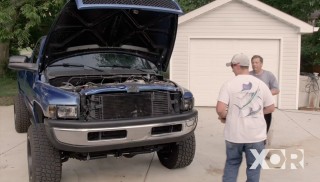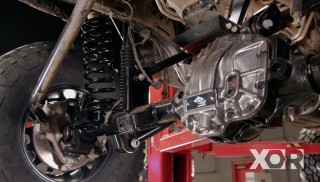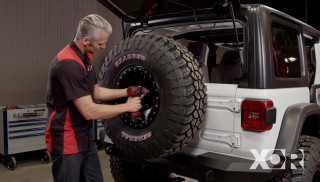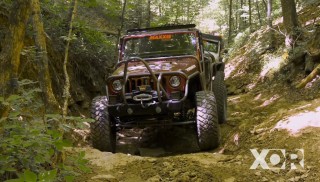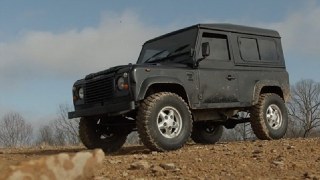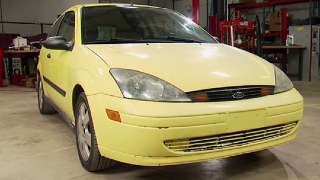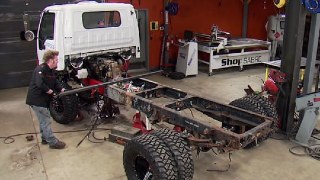XOR - Xtreme Off-Road Builds
Want more content like this?
Join the PowerNation Email NewsletterParts Used In This Episode
Lincoln Electric
Lincoln Electric is the official welding supplier to XOR
Matco Tools
MATCO Tools are the Official Tool Supplier to XOR
The Industrial Depot
Tools, Hardware, and Shop Supplies
Episode Transcript
(Narrator)>> Today on XOR we dust off the welding helmet for a one off set of fabricated fenders on our JL. Plus our Ruby gets a new aggressive sound with a Magnaflow exhaust. All this as the team prepares for the XOR Adventure Ride on XOR. ♪ ♪
(Jeremy)>> Hey guys, welcome to the XOR shop. We're back on the Jeep JL today and this thing has turned into a pretty sweet little project. We've done some suspension upgrades, put on a bigger set of wheels and tires, done some exterior upgrades. We did an axle swap and did some pretty big changes underneath the hood, but there's one thing we haven't touched on yet, and that's front fenders. Now there's a bunch of different aftermarket companies out there with a ton of different parts you can put on your Jeep, but this is XOR and we love to cut, weld, and grind. So a custom set of homemade front fenders it is to help tie this whole front together, and well you know these are made out of plastic and we are not a big fan of plastic. So these are coming off and they're going in the dumpster. Our rear fenders, our bumpers, and our rock sliders, they all have the same look to them. They're very square and very sharp. So when we go to design our front fenders we're gonna keep that same design or that same style in mind, and we're gonna be doing that with some flat plate and some square tubing, and to get started with this whole thing we're gonna go back to our good friend mister cardboard. To make our first pattern we're gonna use the front fender before it hits the garbage can. This is the easiest way to get the shape of the cutout we need. ♪ ♪ Good thick cardboard will help retain the shape of our cutout. ♪ ♪ Now the cardboard piece for our first pattern, well it fits pretty good. Now we've just got to throw this on some metal and cut it out. The best part about this is this piece is interchangeable from side to side. We've got two fenders. So I'll cut two of them out. ♪ ♪ And now I was off just a little bit here. So I'm actually gonna add just a little bit of curvature, and the two points I made, they'll just continue on. ♪ ♪ When I cut with the plasma torch I always make sure to stay on the outside of the black line. That way it can always come back and grind it to fit. We want our front fenders to look as sharp and as clean as our rear fenders. So we're gonna spend a little bit of time here on the belt sander cleaning up the edges from the plasma cutter. [ belt sander buzzing ]
(Jeremy)>> The belt sander is a great tool to have in your shop. We're using a 40 grit belt, which makes short work of the rough edges that the plasma torch left. ♪ ♪ Now safety in the shop, that's one of the most important things you guys can be worried about. Besides for your eyes and your ears, you know your hands are what get all the work done. Lincoln Electric's got a great new product out and that's their steel worker glove. They have an all leather construction, they're extremely form fitting, and they're light weight and breathable. And they're great for working with metal or doing some light welding. If you guys are looking to add some pretty comfy gloves to your tool box go ahead and check out Lincoln Electric's Redline welding apparel. ♪ ♪ Well after a quick trip to the Ironworker I went ahead and punched some holes out so we can use the stock mounting locations. Now this is the base piece of our fender build. So from here we're gonna add some tubing, bring the whole fender out towards us. We'll attach this with just a couple more bolts, and then we'll move on to the skeleton for our fender. ♪ ♪ For those of you guys out there running your four door JL Wranglers over some big boulders and some big rocks you want to make sure that you protect everything underneath your Jeep. Well Rusty's Off Road has a large list of skid plates, and this is a skid plate for your fuel tank. It's made out of three-sixteenths plate steel and it has an E-coated finish. It also comes with all the hardware you need to install it. So if you guys are out on the trails and want to make sure that everything under your truck is nice and safe why don't you guys go check out Rusty's Off Road dot com.
(Narrator)>> Up next, Jeremy burns in some supports and slaps on some sheet metal as these fenders start to take shape on XOR.
(Jeremy)>> Hey guys welcome back to the shop. Now we've made pretty good progress on the front fenders of our JL, but we're getting pretty darn close to doing some welding. So I'm gonna go ahead and add some welding paper to protect the finish of our new truck. Now the rear fenders cover about half of the tire. That's what we're gonna stick with up here in the front. What I'm gonna do is grab some square tubing and start building the skeleton to the fender off of the piece we already made. Then I'm gonna come back and I'll build the edge of the fender. Then I'll come back again and grab some sheet metal and build the skin to the fender. The very first thing I have to do is take a measurement from the piece we already cut to be even with the rock slider. Looks like about three and a quarter. ♪ ♪ [ saw buzzing ]
(Jeremy)>> Our chop saw makes short work of cutting our tubing, and the best part is we can change the fence of the saw to make angle cuts. [ saw buzzing ] ♪ ♪ [ welder crackling ]
(Jeremy)>> We're gonna give our fender some slope. So we're gonna start at the bottom with a short piece and then travel upward getting longer as we go. Our two longest pieces on the top of the fender will be about seven inches. [ saw buzzing ] [ welder crackling ]
(Jeremy)>> And our last piece is the same as the first, about three inches. Now you guys are probably wondering why in the world did we cut such a goofy angle on the end of the tube? Well here's what we have in store. We're gonna take a piece of angle iron and lay it here horizontally. That way this edge will match the edge of our rear fender. Then we're gonna take some sheet metal, lay it in, and start building our skin. [ welder crackling ] ♪ ♪
(Jeremy)>> Now sometimes you've got to give a little to get a little. All I'm worried about here on the edge is matching these two corners. I'll come back later, trim this off, and then we'll just weld it all up. [ welder crackling ]
(Jeremy)>> When welding on a vehicle you always want to make sure you watch where your welding sparks and where your grinding sparks are going because you don't want to ruin the paint on your rig. And you remember that corner we talked about? Well here's how I'll finish it off. ♪ ♪ Now we're gonna give this thing some style points. We're gonna come in with some inch and a half flat strap to build the edge to match the rear fender. ♪ ♪ [ welder crackling ]
(Jeremy)>> A pair of locking pliers help hold all these pieces together. Now we'll just come in with another piece of flat strap, put it on the bottom, and it'll just box this whole thing in. [ welder crackling ]
(Jeremy)>> Well now it's time to move on to the skin of this thing. We're gonna end up taking this off and finishing it on the bench cause it's a whole lot easier to work off of this straight edge than it is to work off of the curvature of the body. ♪ ♪ Alright now it's as simple as putting our sheet metal down here on the straight side, and then just tracing out the curved side. Now off to the band saw. [ saw buzzing ]
(Jeremy)>> There isn't too much curvature to this piece. The band saw makes short work of it. ♪ ♪ [ welder crackling ]
(Jeremy)>> A good pair of C-channel pliers will help pull the metal into place. [ welder crackling ] ♪ ♪
(Jeremy)>> And then from there all we have to do is fill in the fender puzzle. [ welder crackling ] ♪ ♪
(Jeremy)>> Man that is slick. With the front fender mocked up, tacked up, and back on the Jeep you can see that we absolutely nailed the front look to the back look. Now all I've got to do is get this back on the bench and weld it all up. Probably put some kind of coating on it, and then well I've got to build the whole other side.
(Narrator)>> Up next the Jeep JL gets a sick exhaust. The new look and aggressive sound next on XOR.
(Jeremy)>> Hey guys welcome back to XOR. Now our Jeep JL fenders are pretty much buttoned up, and what are you doing down here?
(Austin)>> Hey partner, we had some parts show up to our shop and they're definitely not for us. I figured they were for this rig.
(Jeremy)>> They are. Everybody you know Austin from Truck Tech and he's the host, and I guess he's also the delivery boy huh?
(Austin)>> Jack of all trades man.
(Jeremy)>> Fantastic, that's going underneath our rig and that cart's gonna be empty, and you know what? You can probably take some fenders with you and give them a coating if you're not too busy.
(Austin)>> I figured by the looks of it that'd be your next step being they're in bare metal and all, but I don't mind shooting them cause I'll be in the paint booth anyway. Save you some time and I'm a southern gentleman as they say.
(Jeremy)>> You know what? I've got a great idea. I'm gonna have a whole bunch of extra seats in this Jeep when we go on our XOR Ride. You should come with.
(Austin)>> Now you're talking, sold. I will paint these things pink if you want them pink. You just tell me the color.
(Jeremy)>> Well I'll tell you what. You pick the color. Take some wrenches, you get that side off.
(Austin)>> And I help you.
(Jeremy)>> And I'll take this side off.
(Austin)>> Got it. ♪ ♪
(Jeremy)>> Alright let's get this exhaust out of here. ♪ ♪ One more clamp and the intermediate pipe will come off. ♪ ♪ Come on man I need like half an inch. There! Snake it out of here, yes! Okay so we're gonna cheat on this one. Instead of taking the isolator off I'm gonna take the mount clean off the chassis on both sides. That way we can just drop the whole thing down and deal with this on the bench. The whole thing came down. When we were looking for exhaust on our JL we reached straight out to Magnaflow. They sent us their street series exhaust because the black finish on this matches all the black accents on our Jeep. Their straight through muffler has a complete stainless steel design, and the best part about all of this is it tucks high and tight up inside the JL for better approach and depproach angles. Now the first thing we have to do is install this shiny new muffler. The Magnaflow kit comes with everything you need to install it except for this very first clamp, and then from there we're just gonna keep adding some tubing. Part number two. ♪ ♪ [ drill spinning ] ♪ ♪
(Jeremy)>> The isolator will help hold all this tubing in place until we can come back and tighten everything up. There we go! [ drill spinning ]
(Jeremy)>> With our hangers installed on our new exhaust and a screw jack in place for that extra hand. Hangers lined up, we are good to go. We'll finish up the install. Alright now we all want to know what this thing sounds like. So let's fire it up. [ engine starts and revving ]
(Jeremy)>> Now that's the kind of sound we were looking for out of our JL. [ engine revving ] ♪ ♪
(Jeremy)>> We're getting ready to go on our XOR Adventure Ride and one of the things we're gonna need to bring with us is our big trailer for all of our stuff. The other thing we're gonna need to bring with us is our generator cause we've got a whole lot of camera gear to bring along to make sure that when we film it you guys can see exactly how the ride goes. Our generator has not been run in quite some time, and I've been here for a couple of years. I've never seen this thing run. So we're gonna get this thing out of here. Get it moved into the shop, and give it a once over, and this is way too heavy for me to deal with. So I'm gonna go grab the fork lift, get this thing on a pallet, get it inside, and we'll see what happens. ♪ ♪ We're gonna get rid of the old fuel that's been in this tank for god knows how long and top it off with some fresh stuff. Now on top of that we're gonna be adding some Sea Foam motor treatment. Now Sea Foam is a blend of cleaning and lubricating petroleum ingredients that's safe to use on all two stroke, four stroke, gas, and diesel engines with carburetors and with fuel injection. Now this will help remove harmful deposits from our fuel passageways, intake valves, pistons, and upper chamber areas. Now the next thing we've got to do is get rid of the old fuel, add some fresh stuff, and follow it up with some Sea Foam. ♪ ♪ We're gonna be using this as a cleaning treatment. Now Sea Foam recommends two or more ounces per gallon of fuel for a higher concentration, and that should help us clean out our carburetor. ♪ ♪ [ engine cranking and starting ]
(Jeremy)>> There it goes. [ engine puttering ]
(Jeremy)>> Now this thing actually runs pretty good. We're gonna have to come back, do an oil change, and change out the air filter, but it should all set for us when we go on our XOR Adventure Ride. Now when we put this thing back into storage we're gonna end up using Sea Foam spray as a fogging oil. That way it's all set for the next time we want to use it.
(Narrator)>> Coming up, how to keep the JL road legal after removing the stock fenders, next on XOR.
(Jeremy)>> Hey guys, welcome back. Well we are this close to finally putting some miles on this thing, but with all the add- ons we've done we've got a couple more things that we need to take care of before we go out and see exactly how much power we've got lying underneath the hood.
Now when they first came out with the three point six liter it had an oil weight rating of 5W30. Well since then they've lowered that weight rating cause they were looking for a little better fuel mileage out of this thing. Since we put a supercharger on top we're gonna be adding more pressure to the internal bearings of our engine. So we're gonna bump that weight rating right back up there. Now AMSOIL has sent us their fully synthetic 5W30, and they only use the highest quality base oils, and what that does is means better protection on your engine against higher pressures and well higher temperatures. So I guess the thing we've got to do now is an oil change. ♪ ♪ With the Jeep on the hoist and the catch pan in place we'll get rid of that old oil. ♪ ♪ And then we'll move on to the top side where the oil filter is conveniently located. ♪ ♪ With the supercharger in the way we'll have to fill up our JL through the oil filter housing. ♪ ♪ AMSOIL synthetic motor oil allows you to go longer between oil changes. That's if you choose to do so, even up to 25,000 miles. Alright now a nice new filter and we're all done. ♪ ♪ [ ratchet clicking ] ♪ ♪
(Jeremy)>> When we got rid of our stock fenders we lost our turn signals. So we're gonna put these little l-e-d guys right about there. We'll use some tape and a stepped drill bit to get to the final hole size, which is three quarters of an inch. [ drill spinning ]
(Jeremy)>> The tape helps keep a nice, clean edge. ♪ ♪ We'll put some connectors on so we can plug straight into the stock harness, and then just plug that into the stock location. ♪ ♪
(Austin)>> Some bright little l-e-d's.
(Jeremy)>> Holy cow, you got those done quick.
(Austin)>> Yeah, done man. I'm excited to see what they look like on this thing.
(Jeremy)>> Well let's get them put on.
(Austin)>> Let's do it.
[ ratchet clicking ]
(Austin)>> Alright brother I've got to say I am highly impressed with this design you've conjured up in your head.
(Jeremy)>> You know what? It's pretty amazing what you can do with the right tools and the right parts. Now if you guys are interested in any of the parts we used on the build today go to Powernation TV dot com and we'll see you next time.
Show Full Transcript
(Jeremy)>> Hey guys, welcome to the XOR shop. We're back on the Jeep JL today and this thing has turned into a pretty sweet little project. We've done some suspension upgrades, put on a bigger set of wheels and tires, done some exterior upgrades. We did an axle swap and did some pretty big changes underneath the hood, but there's one thing we haven't touched on yet, and that's front fenders. Now there's a bunch of different aftermarket companies out there with a ton of different parts you can put on your Jeep, but this is XOR and we love to cut, weld, and grind. So a custom set of homemade front fenders it is to help tie this whole front together, and well you know these are made out of plastic and we are not a big fan of plastic. So these are coming off and they're going in the dumpster. Our rear fenders, our bumpers, and our rock sliders, they all have the same look to them. They're very square and very sharp. So when we go to design our front fenders we're gonna keep that same design or that same style in mind, and we're gonna be doing that with some flat plate and some square tubing, and to get started with this whole thing we're gonna go back to our good friend mister cardboard. To make our first pattern we're gonna use the front fender before it hits the garbage can. This is the easiest way to get the shape of the cutout we need. ♪ ♪ Good thick cardboard will help retain the shape of our cutout. ♪ ♪ Now the cardboard piece for our first pattern, well it fits pretty good. Now we've just got to throw this on some metal and cut it out. The best part about this is this piece is interchangeable from side to side. We've got two fenders. So I'll cut two of them out. ♪ ♪ And now I was off just a little bit here. So I'm actually gonna add just a little bit of curvature, and the two points I made, they'll just continue on. ♪ ♪ When I cut with the plasma torch I always make sure to stay on the outside of the black line. That way it can always come back and grind it to fit. We want our front fenders to look as sharp and as clean as our rear fenders. So we're gonna spend a little bit of time here on the belt sander cleaning up the edges from the plasma cutter. [ belt sander buzzing ]
(Jeremy)>> The belt sander is a great tool to have in your shop. We're using a 40 grit belt, which makes short work of the rough edges that the plasma torch left. ♪ ♪ Now safety in the shop, that's one of the most important things you guys can be worried about. Besides for your eyes and your ears, you know your hands are what get all the work done. Lincoln Electric's got a great new product out and that's their steel worker glove. They have an all leather construction, they're extremely form fitting, and they're light weight and breathable. And they're great for working with metal or doing some light welding. If you guys are looking to add some pretty comfy gloves to your tool box go ahead and check out Lincoln Electric's Redline welding apparel. ♪ ♪ Well after a quick trip to the Ironworker I went ahead and punched some holes out so we can use the stock mounting locations. Now this is the base piece of our fender build. So from here we're gonna add some tubing, bring the whole fender out towards us. We'll attach this with just a couple more bolts, and then we'll move on to the skeleton for our fender. ♪ ♪ For those of you guys out there running your four door JL Wranglers over some big boulders and some big rocks you want to make sure that you protect everything underneath your Jeep. Well Rusty's Off Road has a large list of skid plates, and this is a skid plate for your fuel tank. It's made out of three-sixteenths plate steel and it has an E-coated finish. It also comes with all the hardware you need to install it. So if you guys are out on the trails and want to make sure that everything under your truck is nice and safe why don't you guys go check out Rusty's Off Road dot com.
(Narrator)>> Up next, Jeremy burns in some supports and slaps on some sheet metal as these fenders start to take shape on XOR.
(Jeremy)>> Hey guys welcome back to the shop. Now we've made pretty good progress on the front fenders of our JL, but we're getting pretty darn close to doing some welding. So I'm gonna go ahead and add some welding paper to protect the finish of our new truck. Now the rear fenders cover about half of the tire. That's what we're gonna stick with up here in the front. What I'm gonna do is grab some square tubing and start building the skeleton to the fender off of the piece we already made. Then I'm gonna come back and I'll build the edge of the fender. Then I'll come back again and grab some sheet metal and build the skin to the fender. The very first thing I have to do is take a measurement from the piece we already cut to be even with the rock slider. Looks like about three and a quarter. ♪ ♪ [ saw buzzing ]
(Jeremy)>> Our chop saw makes short work of cutting our tubing, and the best part is we can change the fence of the saw to make angle cuts. [ saw buzzing ] ♪ ♪ [ welder crackling ]
(Jeremy)>> We're gonna give our fender some slope. So we're gonna start at the bottom with a short piece and then travel upward getting longer as we go. Our two longest pieces on the top of the fender will be about seven inches. [ saw buzzing ] [ welder crackling ]
(Jeremy)>> And our last piece is the same as the first, about three inches. Now you guys are probably wondering why in the world did we cut such a goofy angle on the end of the tube? Well here's what we have in store. We're gonna take a piece of angle iron and lay it here horizontally. That way this edge will match the edge of our rear fender. Then we're gonna take some sheet metal, lay it in, and start building our skin. [ welder crackling ] ♪ ♪
(Jeremy)>> Now sometimes you've got to give a little to get a little. All I'm worried about here on the edge is matching these two corners. I'll come back later, trim this off, and then we'll just weld it all up. [ welder crackling ]
(Jeremy)>> When welding on a vehicle you always want to make sure you watch where your welding sparks and where your grinding sparks are going because you don't want to ruin the paint on your rig. And you remember that corner we talked about? Well here's how I'll finish it off. ♪ ♪ Now we're gonna give this thing some style points. We're gonna come in with some inch and a half flat strap to build the edge to match the rear fender. ♪ ♪ [ welder crackling ]
(Jeremy)>> A pair of locking pliers help hold all these pieces together. Now we'll just come in with another piece of flat strap, put it on the bottom, and it'll just box this whole thing in. [ welder crackling ]
(Jeremy)>> Well now it's time to move on to the skin of this thing. We're gonna end up taking this off and finishing it on the bench cause it's a whole lot easier to work off of this straight edge than it is to work off of the curvature of the body. ♪ ♪ Alright now it's as simple as putting our sheet metal down here on the straight side, and then just tracing out the curved side. Now off to the band saw. [ saw buzzing ]
(Jeremy)>> There isn't too much curvature to this piece. The band saw makes short work of it. ♪ ♪ [ welder crackling ]
(Jeremy)>> A good pair of C-channel pliers will help pull the metal into place. [ welder crackling ] ♪ ♪
(Jeremy)>> And then from there all we have to do is fill in the fender puzzle. [ welder crackling ] ♪ ♪
(Jeremy)>> Man that is slick. With the front fender mocked up, tacked up, and back on the Jeep you can see that we absolutely nailed the front look to the back look. Now all I've got to do is get this back on the bench and weld it all up. Probably put some kind of coating on it, and then well I've got to build the whole other side.
(Narrator)>> Up next the Jeep JL gets a sick exhaust. The new look and aggressive sound next on XOR.
(Jeremy)>> Hey guys welcome back to XOR. Now our Jeep JL fenders are pretty much buttoned up, and what are you doing down here?
(Austin)>> Hey partner, we had some parts show up to our shop and they're definitely not for us. I figured they were for this rig.
(Jeremy)>> They are. Everybody you know Austin from Truck Tech and he's the host, and I guess he's also the delivery boy huh?
(Austin)>> Jack of all trades man.
(Jeremy)>> Fantastic, that's going underneath our rig and that cart's gonna be empty, and you know what? You can probably take some fenders with you and give them a coating if you're not too busy.
(Austin)>> I figured by the looks of it that'd be your next step being they're in bare metal and all, but I don't mind shooting them cause I'll be in the paint booth anyway. Save you some time and I'm a southern gentleman as they say.
(Jeremy)>> You know what? I've got a great idea. I'm gonna have a whole bunch of extra seats in this Jeep when we go on our XOR Ride. You should come with.
(Austin)>> Now you're talking, sold. I will paint these things pink if you want them pink. You just tell me the color.
(Jeremy)>> Well I'll tell you what. You pick the color. Take some wrenches, you get that side off.
(Austin)>> And I help you.
(Jeremy)>> And I'll take this side off.
(Austin)>> Got it. ♪ ♪
(Jeremy)>> Alright let's get this exhaust out of here. ♪ ♪ One more clamp and the intermediate pipe will come off. ♪ ♪ Come on man I need like half an inch. There! Snake it out of here, yes! Okay so we're gonna cheat on this one. Instead of taking the isolator off I'm gonna take the mount clean off the chassis on both sides. That way we can just drop the whole thing down and deal with this on the bench. The whole thing came down. When we were looking for exhaust on our JL we reached straight out to Magnaflow. They sent us their street series exhaust because the black finish on this matches all the black accents on our Jeep. Their straight through muffler has a complete stainless steel design, and the best part about all of this is it tucks high and tight up inside the JL for better approach and depproach angles. Now the first thing we have to do is install this shiny new muffler. The Magnaflow kit comes with everything you need to install it except for this very first clamp, and then from there we're just gonna keep adding some tubing. Part number two. ♪ ♪ [ drill spinning ] ♪ ♪
(Jeremy)>> The isolator will help hold all this tubing in place until we can come back and tighten everything up. There we go! [ drill spinning ]
(Jeremy)>> With our hangers installed on our new exhaust and a screw jack in place for that extra hand. Hangers lined up, we are good to go. We'll finish up the install. Alright now we all want to know what this thing sounds like. So let's fire it up. [ engine starts and revving ]
(Jeremy)>> Now that's the kind of sound we were looking for out of our JL. [ engine revving ] ♪ ♪
(Jeremy)>> We're getting ready to go on our XOR Adventure Ride and one of the things we're gonna need to bring with us is our big trailer for all of our stuff. The other thing we're gonna need to bring with us is our generator cause we've got a whole lot of camera gear to bring along to make sure that when we film it you guys can see exactly how the ride goes. Our generator has not been run in quite some time, and I've been here for a couple of years. I've never seen this thing run. So we're gonna get this thing out of here. Get it moved into the shop, and give it a once over, and this is way too heavy for me to deal with. So I'm gonna go grab the fork lift, get this thing on a pallet, get it inside, and we'll see what happens. ♪ ♪ We're gonna get rid of the old fuel that's been in this tank for god knows how long and top it off with some fresh stuff. Now on top of that we're gonna be adding some Sea Foam motor treatment. Now Sea Foam is a blend of cleaning and lubricating petroleum ingredients that's safe to use on all two stroke, four stroke, gas, and diesel engines with carburetors and with fuel injection. Now this will help remove harmful deposits from our fuel passageways, intake valves, pistons, and upper chamber areas. Now the next thing we've got to do is get rid of the old fuel, add some fresh stuff, and follow it up with some Sea Foam. ♪ ♪ We're gonna be using this as a cleaning treatment. Now Sea Foam recommends two or more ounces per gallon of fuel for a higher concentration, and that should help us clean out our carburetor. ♪ ♪ [ engine cranking and starting ]
(Jeremy)>> There it goes. [ engine puttering ]
(Jeremy)>> Now this thing actually runs pretty good. We're gonna have to come back, do an oil change, and change out the air filter, but it should all set for us when we go on our XOR Adventure Ride. Now when we put this thing back into storage we're gonna end up using Sea Foam spray as a fogging oil. That way it's all set for the next time we want to use it.
(Narrator)>> Coming up, how to keep the JL road legal after removing the stock fenders, next on XOR.
(Jeremy)>> Hey guys, welcome back. Well we are this close to finally putting some miles on this thing, but with all the add- ons we've done we've got a couple more things that we need to take care of before we go out and see exactly how much power we've got lying underneath the hood.
Now when they first came out with the three point six liter it had an oil weight rating of 5W30. Well since then they've lowered that weight rating cause they were looking for a little better fuel mileage out of this thing. Since we put a supercharger on top we're gonna be adding more pressure to the internal bearings of our engine. So we're gonna bump that weight rating right back up there. Now AMSOIL has sent us their fully synthetic 5W30, and they only use the highest quality base oils, and what that does is means better protection on your engine against higher pressures and well higher temperatures. So I guess the thing we've got to do now is an oil change. ♪ ♪ With the Jeep on the hoist and the catch pan in place we'll get rid of that old oil. ♪ ♪ And then we'll move on to the top side where the oil filter is conveniently located. ♪ ♪ With the supercharger in the way we'll have to fill up our JL through the oil filter housing. ♪ ♪ AMSOIL synthetic motor oil allows you to go longer between oil changes. That's if you choose to do so, even up to 25,000 miles. Alright now a nice new filter and we're all done. ♪ ♪ [ ratchet clicking ] ♪ ♪
(Jeremy)>> When we got rid of our stock fenders we lost our turn signals. So we're gonna put these little l-e-d guys right about there. We'll use some tape and a stepped drill bit to get to the final hole size, which is three quarters of an inch. [ drill spinning ]
(Jeremy)>> The tape helps keep a nice, clean edge. ♪ ♪ We'll put some connectors on so we can plug straight into the stock harness, and then just plug that into the stock location. ♪ ♪
(Austin)>> Some bright little l-e-d's.
(Jeremy)>> Holy cow, you got those done quick.
(Austin)>> Yeah, done man. I'm excited to see what they look like on this thing.
(Jeremy)>> Well let's get them put on.
(Austin)>> Let's do it.
[ ratchet clicking ]
(Austin)>> Alright brother I've got to say I am highly impressed with this design you've conjured up in your head.
(Jeremy)>> You know what? It's pretty amazing what you can do with the right tools and the right parts. Now if you guys are interested in any of the parts we used on the build today go to Powernation TV dot com and we'll see you next time.


